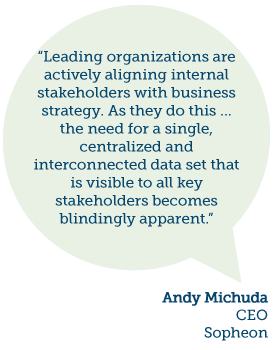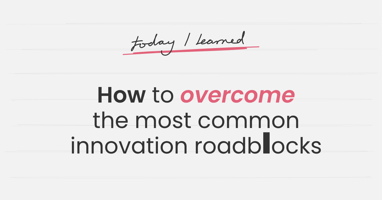This is the second in a 3-part series by Sopheon's CEO, Andy Michuda. Read Part 3 >
In Part 1 of this series, I introduced the two key market factors driving the new norm economics of the digital age: consumerization and the digitization of business.
In my opinion, the nexus of the these factors has disrupted three central operational business capabilities in the competitive enterprise, and these will all need to be addressed for a company to be successful – or at the risk of being overly dramatic, even remain in business:
- The concept of the Annual Operating Plan (AOP) is outdated — reviewing and updating operating plans just once a year simply doesn't equip an enterprise to act or respond quickly.
- The execution of corporate strategic plans leaves ample room for improvement — if 91% of corporations have a gap in alignment between product development and growth strategies1, then many of the resources invested in product development are being wasted on non-strategic activity.
- The performance of enterprise innovation strategies and initiatives must improve or the organization will die — with some 50% of innovation initiatives failing2, companies need to improve their innovation performance to grow and maintain a competitive edge.
Let's dig a little deeper into the first two. The need to improve the performance of innovation strategies and initiatives will be the topic of the third post in this series.
AOP is Outdated
The traditional corporate annual planning process is a time-intensive prioritization of forward-looking objectives, initiatives, and budgets. We have seen this take as long as nine months to lock down on annual plans. The market is simply moving too fast today to support such a lengthy planning cycle. Chances are, by the time tactics are operational the market has already moved on or a competitor may very likely have swooped in to claim a first mover advantage.
Many of our clients are moving from a static, protracted AOP practice to one that is dynamic and responsive. However, the fundamental challenge with implementing enterprise-wide agility is that most businesses are not properly wired or connected to dynamically iterate their strategic plans. The traditional techniques, tools and processes used in managing the AOP process — Microsoft ® Excel ® and PowerPoint ® documents scattered throughout the organization — do not enable the linkage of cross-functional information or facilitate the speed that underpin dynamic decision making.
A deliberate effort to become an interconnected enterprise, one that is digitally connected with useable, shareable data across the entire organization in a way that allows the organization to move forward dynamically with grace, irrespective of company size or organizational complexity. Initiatives, priorities, and investments should be shared in a common repository that gives visibility to status, conflicts, dependencies, and change. This connected data can then serve as the enterprise's single source of truth, allowing the business to make truly informed portfolio decisions and adjust to stay ahead of competitors.
Strategy Execution Remains Problematic
Generally speaking, the speed of strategic planning isn't the only problem. Communication and execution of these plans in a timely manner is where organizations typically run into trouble. Fifty-five percent of managers can't name one of their organizations top five priorities. 3 Further, a meager 3% of firms successfully align growth strategies with product development while the overwhelming majority are aware of a gap between strategy and development. 1 Enterprises are not realizing their own strategic targets, and this new era is quickly sorting the business winners from the business losers.
Companies generally fail to realize their strategic initiatives for the following reasons:
- There is a lack of strategy alignment across the organization.
- Organizations don't treat strategy alignment with the same priority as quarterly financial performance.
- Initiatives become outdated and irrelevant before making an impact.
Leading organizations are actively aligning internal stakeholders with business strategy. As they do this and move to faster review and planning cycles, the need for a single, centralized and interconnected data set that is visible to all key stakeholders becomes blindingly apparent. These organizations are transforming not only their structures and how they work, but also the underlying tools for their corresponding knowledge management and necessary cross-functional collaboration. Their internal business transformation lays the foundation enabling growth and successful market innovations.
The question to CEOs around the world is, "What are you DOING to win and grow in the face of these new norm market conditions?"
READ PART 3
Related Resources
- Ebook: The Essential 5 Capabilities Every Organization Needs to Successfully Execute Innovation Strategy
- On-Demand Webinar: How to Overcome the Innovation and Strategic Business Alignment Disconnect
- White Paper: Aligning Product Portfolios with Strategic Plans
REFERENCES
1 Consumer Goods Technology (CGT), "New Product Introduction, Product Launches Hindered by Major Challenges", 16 September 2011
2 Edgett, S.J., "Innovation Performance: Critical Drivers of Success", Stage-Gate International, AQPC, 2014
3 Fitzgerald, Donna and Jones, Teresa, "Market Guide for Enterprise PPM Software", Gartner, 23 September 2015
Microsoft, Excel and PowerPoint are registered trademarks or trademarks of Microsoft Corporation in the United States and/or other countries.





